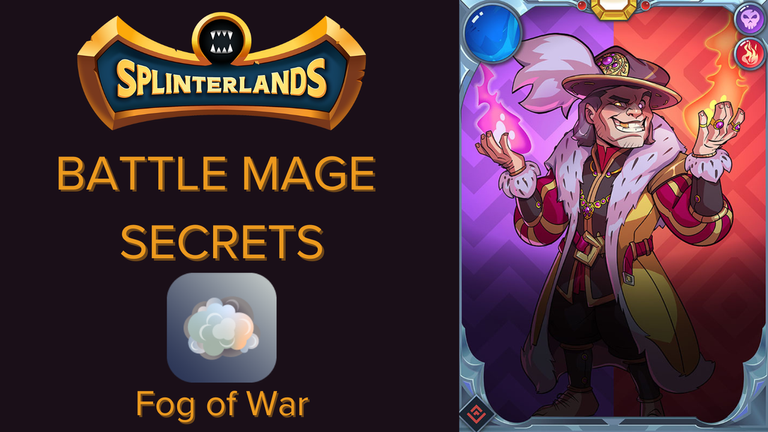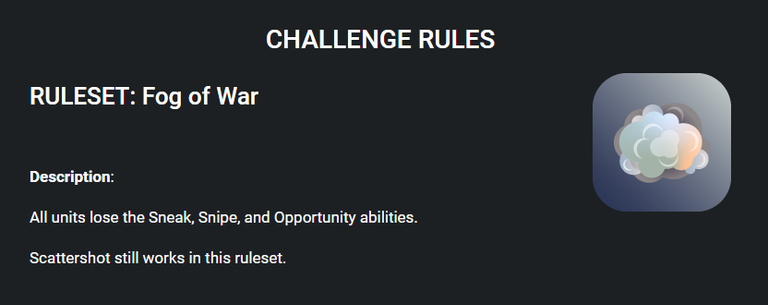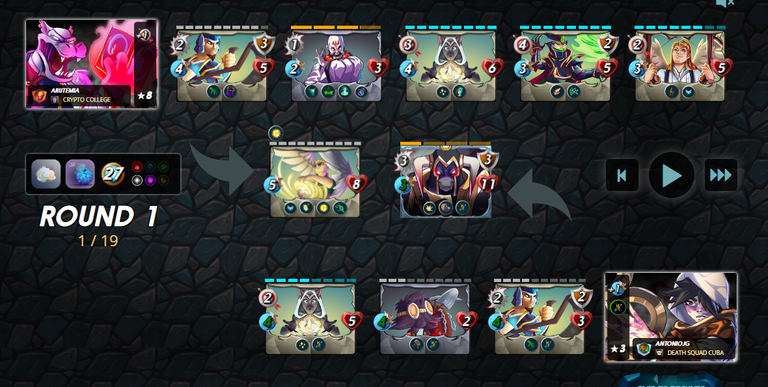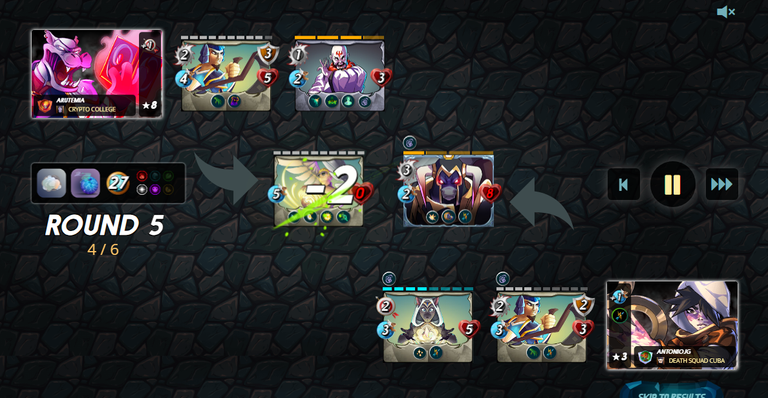Fog of War Ruleset - Una estrategia interesante combinando las habilidades “Shield” & “Return Fire” con el Splinter de Vida [Es/En]

Español
¡Saludos comunidad! El reto de esta semana es sobre una regla de batalla que no permite utilizar tres habilidades en la batalla. En la siguiente sección se explicará más a detalle, por lo que tener en cuenta este aspecto en el análisis para formar nuestras estrategias, es un factor clave con un impacto considerable en el desempeño de las mismas. Es importante recordar que el tipo de ofensiva a utilizar en nuestras estrategias también dependerá del resto de reglas presentes en la batalla.
En esta oportunidad, les explicaré cómo afronté una batalla de Ranked de la liga de Plata en el formato Moderno, enfocando mi análisis en explicar cómo utilicé al Splinter de Vida, el invocador Ilthain y las unidades Mantaroth, Sunkai Harvester, Scavo Hireling y Venari Crystalsmith para ser coherente con las reglas de batalla presentes y las habilidades que quería combinar con la finalidad de tomar ventaja en la partida con la estrategia planteada.
Ya que estos aspectos son un factor clave con un impacto considerable en el desempeño de nuestras estrategias.

Fog of War Ruleset

Fog of War es una regla que no permite utilizar las habilidades: “Snipe”, “Sneak” y “Opportunity” en la batalla.
Entonces, conociendo estos detalles, es importante estár familiarizado con estrategias que no dependan de dichas habilidades. Lo recomendable, es incluir habilidades de soporte y contraataque, tales como: “Shield”, “Void”, “Void Armor”, “Tank Heal”, “Repair”, “Return Fire”, “Magic Reflect”, “Thorns”, “Retaliate”, entre otras.

Conjunto de reglas y elección

Hablemos sobre el conjunto de reglas presentes en la batalla, este es el punto de partida para iniciar el análisis que nos llevará a la elección más adecuada para afrontar la batalla.
Límite de maná igual a 27 puntos, esta cantidad nos permite elegir invocadores con un costo de maná entre 4 y 7 puntos. Es importante tener una estrategia definida para aprovechar adecuadamente el maná restante para la elección adecuada de las unidades.
La regla “Fog of War” ya la expliqué a detalle en la sección anterior. Por otra parte, Lost Magic, es una regla que no permite utilizar unidades de tipo magia en la batalla.
Entonces, tomando en cuenta todos estos aspectos, decidí utilizar al Splinter de Vida, ya que cuenta con unidades que poseen buenas estadísticas, entre ellas, un buen daño melee y ranged. También cuenta con habilidades como: “Shield”, “Armored Strike”, “Reach”, “Repair”, “Tank Heal”, entre otras y con un invocador que incrementa en 1 punto velocidad del equipo y les otorga la habilidad “Return Fire”.

Equipo y estrategia

Hablemos sobre el equipo y la estrategia que conforma. Dadas las circunstancias, era evidente el uso de los tipos de daño melee y ranged. Es por ello que decidí elegir al invocador Ithain, ya que incrementa en 1 punto velocidad del equipo y les otorga la habilidad “Return Fire”.
Mantaroth fue el tanque en esta oportunidad, ya que cuenta con buenas estadísticas, entre ellas, sus puntos de vida y ataque. También posee la habilidad “Shield”, la cual le permite aumentar su resistencia contra el daño melee y ranged.
Sunkai Harvester contribuye con su ataque desde la segunda posición mediante la habilidad “Reach”, apoyando a Mantaroth para debilitar al tanque enemigo.
Scavo Hireling tiene un rol clave en el equipo, ya que su objetivo es dar soporte al tanque mediante la habilidad “Repair” para aumentar su resistencia contra el daño enemigo.
Venari Crystalsmith también tiene una participación clave en la estrategia, ya que además de contribuir con su ataque, da soporte al tanque mediante la habilidad “Tank Heal”, ayudándolo a resistir un poco más el daño enemigo.

Fog of War Ruleset en acción

Como les mencioné anteriormente, elegir al invocador Ilthain y las unidades Mantaroth, Sunkai Harvester, Scavo Hireling y Venari Crystalsmith, fue una buena opción. Sin embargo, también es importante incluir habilidades de soporte que le permitan a nuestro tanque y al resto del equipo, resistir lo suficiente.
Observen como para el turno 4 de la ronda 5, el equipo enemigo estaba casi abatido. Mantaroth resistió bastante bien en la primera posición gracias al soporte por parte de Scavo Hireling y Venari Crystalsmith. Por otra parte, la contribución de Sunkai Harvester también fue clave para debilitar al enemigo.
Si quieres ver la batalla completa, acá te dejo el enlace: CLIC PARA VER LA BATALLA

Conclusión
La estrategia planteada hizo un uso eficiente de la cantidad de maná disponible, cubriendo aspectos tales como: resistencia contra el daño enemigo, soporte del equipo, una buena ofensiva, y coherencia con el conjunto de reglas presente.
Una debilidad de esta estrategia es un equipo enemigo que cuente con resistencia contra el daño melee y ranged. Además que incluya en su estrategia habilidades como: “Shield”, “Repair”, “Tank Heal”, “Cleanse”, “Affliction”, “Demoralize”, “Headwind”, “Thorns”, “Retaliate”, “Return Fire”, entre otras.
La diferencia entre las estrategias fue que el equipo enemigo no incluyó habilidades de soporte para las unidades en su segunda línea. Por lo que fueron debilitadas rápidamente mediante el daño retornado por la habilidad “Return Fire”. Lo que desestabilizó su estrategia totalmente.
Para el funcionamiento adecuado de nuestras estrategias, es importante considerar todos los aspectos involucrados, por lo que no sólo debemos enfocarnos en las estadísticas y habilidades a combinar. También debemos tener en cuenta la influencia de los conjuntos de reglas sobre la estrategia.
Este ha sido mi aporte al desafío semanal, ¡Espero haya sido de su agrado! ¡Saludos y hasta la próxima semana!

English
Greetings community! This week's challenge is about a battle rule that does not allow the use of three skills in battle. The next section will explain this in more detail, so taking this aspect into account in our analysis to shape our strategies is a key factor with a significant impact on their performance. It is important to remember that the type of offense to use in our strategies will also depend on the rest of the rules present in the battle.
On this occasion, I will explain how I faced a Ranked battle in the Silver league in the Modern format, focusing my analysis on explaining how I used the Life Splinter, the summoner Ilthain, and the Mantaroth, Sunkai Harvester, Scavo Hireling, and Venari Crystalsmith units to be consistent with the present battle rules and the skills I wanted to combine in order to gain an advantage in the game with the strategy proposed.
Since these aspects are a key factor with a considerable impact on the performance of our strategies.

Fog of War Ruleset

Fog of War is a rule that does not allow the use of the abilities: "Snipe", "Sneak" and "Opportunity" in battle.
Therefore, knowing these details, it is important to be familiar with strategies that do not depend on these abilities. The recommendation is to include support and counterattack skills, such as: "Shield", "Void", "Void Armor", "Tank Heal", "Repair", "Return Fire", "Magic Reflect", "Thorns", "Retaliate", among others.

Rulesets and choise

Let's talk about the set of rules present in the battle, this is the starting point to start the analysis that will lead us to the most appropriate choice to face the battle.
Mana limit equal to 27 points, this amount allows us to choose summoners with a mana cost between 4 and 7 points. It is important to have a defined strategy to adequately take advantage of the remaining mana for the appropriate choice of units.
The "Fog of War" rule, I already explained in detail in the previous section. On the other hand, Lost Magic, is a rule that does not allow the use of magic type units in battle.
So, taking into account all these aspects, I decided to use the Life Splinter, as it has units that have good statistics, among them, good melee and ranged damage. It also has abilities like: "Shield", "Armored Strike", "Reach", "Repair", "Tank Heal", among others and with a summoner that increases the team's speed by 1 point and gives them the "Return Fire" ability.

Team and strategy

Let's talk about the team and the strategy that it forms. Given the circumstances, the use of melee and ranged damage types was evident. That is why I decided to choose the summoner Ithain, as it increases the team's speed by 1 point and grants them the "Return Fire" ability.
Mantaroth was the tank on this occasion, as it has good stats, including its health points and attack. It also has the "Shield" ability, which allows it to increase its resistance against melee and ranged damage.
Sunkai Harvester contributes with its attack from the second position through the "Reach" ability, supporting Mantaroth to weaken the enemy tank.
Scavo Hireling has a key role in the team, as its objective is to support the tank through the "Repair" ability to increase its resistance against enemy damage.
Venari Crystalsmith also has a key role in the strategy, as in addition to contributing with its attack, it supports the tank through the "Tank Heal" ability, helping it to resist a little more enemy damage.

Fog of War Ruleset in action

As I mentioned earlier, choosing the summoner Ilthain and the units Mantaroth, Sunkai Harvester, Scavo Hireling, and Venari Crystalsmith, was a good choice. However, it is also important to include support abilities that allow our tank and the rest of the team to endure enough.
Observe how by turn 4 of round 5, the enemy team was almost defeated. Mantaroth held up quite well in the first position thanks to the support from Scavo Hireling and Venari Crystalsmith. On the other hand, the contribution of Sunkai Harvester was also key to weakening the enemy.
If you want to see the complete battle, here you have the link: CLICK TO WATCH THE BATTLE

Conclusion
The strategy proposed made efficient use of the amount of mana available, covering aspects such as: resistance against enemy damage, team support, good offense, and coherence with the present rule set.
A weakness of this strategy is an enemy team that has resistance against melee and ranged damage. Also include in your strategy skills such as: "Shield", "Repair", "Tank Heal", "Cleanse", "Affliction", "Demoralize", "Headwind", "Thorns", "Retaliate", "Return Fire", among others.
The difference between the strategies was that the enemy team did not include support abilities for the units in their second line. So they were quickly weakened by the damage returned by the "Return Fire" skill. This totally destabilized their strategy.
For the proper functioning of our strategies, it is important to consider all aspects involved, so we should not only focus on the statistics and skills to be combined. We must also take into account the influence of the rule sets on the strategy.
This has been my contribution to the weekly challenge, I hope you enjoyed it! Greetings and see you next week!

Te invito a seguirme en / I invite you to follow me on: X
Las traducciones fueron realizadas con el traductor / Translations were done with the translator: DeepL
Todas las imágenes fueron tomadas de / and all images were taken from: Splinterlands

https://twitter.com/AntonioJGB92/status/1781797384663580980
https://www.reddit.com/r/Splinterlands/comments/1c912xg/fog_of_war_ruleset_una_estrategia_interesante/
https://reddit.com/r/Splinterlands/comments/1c912xg/fog_of_war_ruleset_una_estrategia_interesante/
The rewards earned on this comment will go directly to the people( @antoniojg ) sharing the post on Reddit as long as they are registered with @poshtoken. Sign up at https://hiveposh.com.
Checkout our BDVoter Daily Hive Showcase & Participate into our Daily giveaway to win various prize.
Thanks for sharing! - @alokkumar121

Thanks ! | ¡Gracias! 👍